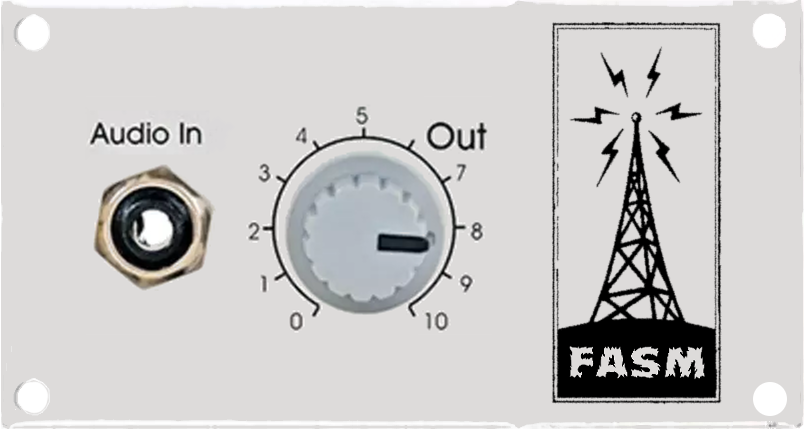MechaSeb
Admin
Messages : 4395
Date d'inscription : 15/10/2010
Age : 40
 |  Sujet: Harvestman Double Andore Sujet: Harvestman Double Andore  Mer Déc 15 2010, 10:30 Mer Déc 15 2010, 10:30 | |
| Voici la facade d'un des modules à venir. [Vous devez être inscrit et connecté pour voir cette image] | |
|
Yohda
Lama-mia !

Messages : 756
Date d'inscription : 08/11/2010
 |  Sujet: Re: Harvestman Double Andore Sujet: Re: Harvestman Double Andore  Mer Déc 15 2010, 10:48 Mer Déc 15 2010, 10:48 | |
| Je viens de voir ça aussi !  Super interressant, ça me fait penser à un "hybride" entre un Math/VCS et le concept de l'Envelooper de Grant Richter dont on parlait dimanche avec les wavetables. A propos de l'envelooper : - Citation :
- Short version:
"Think of it as a sampler for the control signals that make up synthesis, rather than the audio output of the synthesis. That means it is parametric, which means you can goof around with the routing of signals, reversing signals, switching the order of signals in order to create new phrases from other material."
Long version:
"I can tell you the most about the Envelooper as I am almost ready to start PC board layout for that one.
Back in 1999, a 27C512 EPROM cost about $5, now the 27C801 EPROM, which is a 1 megabyte unit is the same price. So all the new designs are going to use the 1 megabyte EPROM for storage.
The larger EPROM sizes are pin compatible with earlier pin layouts like the 27C512. You can actually wire a Grayhill binary encoder (from Allied for about $15) to the extra 4 address pins on a 27C801 and plug it into a Wavefrom City board. That would give you the equivalent of 16 x 27C512 in the same space. That is if there are now 16 software banks for the Wavefrom City and Mini-wave. Dave Hylanders board is nice because it give you voltage controlled selectrion of 10 EPROMs, but you can fit a chip to hold 16 chips worth with a little kludging to any Waveform City or Mini-wave with a rotary selector switch.
The Mini-wave is a single arbitrary function generator (the least expensive ever offered). The Envelooper is a multiple arbitrary function generator. It has 4 outputs each of which will output one Mini-wave or Waveform City waveform at the same time. The Envelooper is setup to use these waveforms for control purposes.
The Buchla MARF is really nice, except it looks very complicated to use and understand. I tried to come up with a MARF that has an easy to understand user interface. I used something familiar, it is modelled after an ADSR. Each section of A,D,S and R is one 256 byte Mini-wave waveform, so 4 of these play in series (set by ADSR logic) for a total of 1024 steps, each on 4 individual tracks.
The tracks are targeted to certain functions: Track one is for pitches, track two is for waveshape control, track three is for VCF control and track four is for VCA control. But they don't have to be used that way, they are just control signals, and you can route them anywhere in the patch.
I tried drawing the waveforms with Wave256, with little success. I tried a program to
convert .MID files to the control signals, that is OK, but limits you to keyboard type phrases.
What I needed was a way to record actual control signal from all the synths that I have ito the correct format time aligned on 4 channels. Just yesterday I succeded in getting such a system working. I can now record control signals from my ARP2600, 1603 sequencer, all of the Buchla stuff, Joysticks, JAGs, Steiner EVIs and anything else that makes a usable set of control voltage, then store them as musical control signals on 4 paralell tracks.
The Envelooper has several operating modes. In "one shot" mode it behave just like an ADSR, using the gate and trigger signals. When gate and trigger go high, it goes to the attack phase and plays out the 256 values stored on each of 4 channels, then it switches to the decay phase and does the same, unless gate goes low, then it jumps to release phase, or a new trigger will make it jump to the begining of attack. If it gets to sustain, it loops at sustain until gate goes low, or a new trigger comes in.
That makes it sound complicated, but it is very intuative. There are 3 loop modes, in mode 1, it plays A-D-S-R in sequence and the time for each section is adjustable from 1 millisecond to about 25 seconds per section with 4 knobs. In mode 2, only the attack knob controls the loop speed for all sections (handy when you are using it like a sequencer). Mode 3 plays each section in reverse. There is a switch that will link the pitches to the playback speed so it acts like a tape recording would. Slower playback lowers the pitches, and faster playback increases the pitchs.
Think of it as a sampler for the control signals that make up synthesis, rather than the audio output of the synthesis. That means it is parametric, which means you can goof around with the routing of signals, reversing signals, switching the order of signals in order to create new phrases from other material.
Since there are 16 x 256 = 4096 section in the new PROM, I am inthe process of programming all 4096 waveshapes to make some kind of usable musical "gesture". The need to be a bit generic, so it is not just a tape recorder, but has snippets of musically useful material stored and ready to use in your compositions.
No one has ever do anything like it to my knowlwedge, which is the whole point of trying to advance the state of the art.
I am trying to be brief, but I hope that gives some idea of the new control module in the pipeline.
Maybe Gary or Doc will be willing to comment on the "gestural" theory of music analysis.
I am also being inpired by the work of the "sentics" people who relate physical gesture to emotion. Initially, they were studying the shapes of musical instrument key action over time and how it related to perceived emotion. Now they seem to have gone completely "new wave" and generalized the idea to far too much. But the core concept is still useful." | |
|

